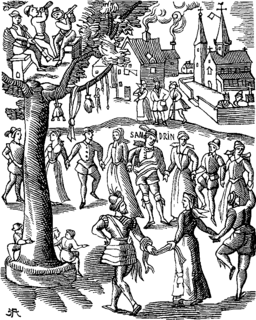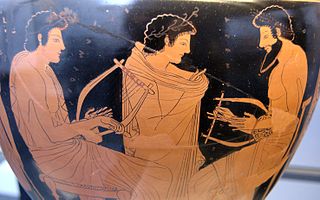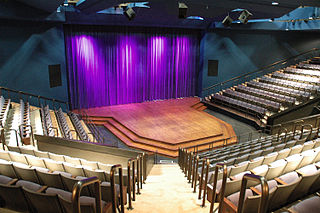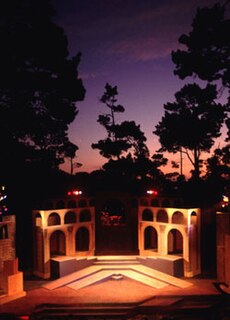
The following outline is provided as an overview of and topical guide to theatre:

A black box theater is a simple performance space, that varies in size, and is usually a square room with black walls and a flat floor. The simplicity of the space is used to create a flexible stage and audience interaction. The black box is a relatively recent innovation in theatre.

A stripper or exotic dancer is a person whose occupation involves performing striptease in a public adult entertainment venue such as a strip club. At times, a stripper may be hired to perform at a bachelor party or other private event.

Experimental theatre began in Western theatre in the late 19th century with Alfred Jarry and his Ubu plays as a rejection of both the age in particular and, in general, the dominant ways of writing and producing plays. The term has shifted over time as the mainstream theatre world has adopted many forms that were once considered radical.

Strip clubs are venues where strippers provide adult entertainment, predominantly in the form of striptease or other erotic or exotic dances. Strip clubs typically adopt a nightclub or bar style, and can also adopt a theatre or cabaret-style. American-style strip clubs began to appear outside North America after World War II, arriving in Asia in the late 1980s and Europe in the 1978, where they competed against the local English and French styles of striptease and erotic performances.

In theatre and performing arts, the stage is a designated space for the performance of productions. The stage serves as a space for actors or performers and a focal point for the members of the audience. As an architectural feature, the stage may consist of a platform or series of platforms. In some cases, these may be temporary or adjustable but in theaters and other buildings devoted to such productions, the stage is often a permanent feature.

A vomitorium is a passage situated below or behind a tier of seats in an amphitheatre or a stadium, through which big crowds can exit rapidly at the end of a performance. They can also be pathways for actors to enter and leave stage. The Latin word vomitorium, plural vomitoria, derives from the verb vomō, vomere, "to spew forth". In ancient Roman architecture, vomitoria were designed to provide rapid egress for large crowds at amphitheatres and stadia, as they do in modern sports stadia and large theatres.

The Etobicoke School of the Arts (ESA) is a specialized public arts-academic high school located in the Etobicoke area of Toronto, Ontario, Canada Royal York Collegiate Institute facility. Founded on September 8, 1981, the Etobicoke School of the Arts has the distinction of being the oldest, free standing, arts-focused high school in Canada.
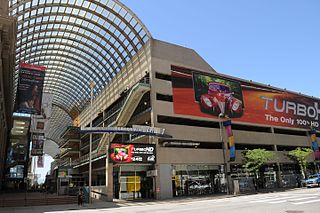
The Denver Performing Arts Complex located in Denver, Colorado, is one of the largest performing arts centers in the United States. The DPAC is a four-block, 12-acre (49,000 m2) site containing ten performance spaces with over 10,000 seats connected by an 80 ft (24 m) tall glass roof. It is home to a theatre company, Broadway touring productions, contemporary dance and ballet, chorales, a symphony orchestra, opera and more.

The National Centre for the Performing Arts (NCPA) is a multi-venue, multi-purpose cultural centre in Mumbai, India, which aims to promote and preserve India's heritage of music, dance, theatre, film, literature and photography. It also presents new and innovative work in the performing arts field. The Centre was founded in 1969 by JRD Tata and Dr. Jamshed Bhabha,.

The Dolman Theatre is located in the city of Newport, Wales, United Kingdom. The theatre was formally an integral part of Kingsway Shopping Centre until major restructuring of the shopping centre forced what was the main entrance of the theatre to be closed; the theatre was refurbished in 2005, with what was the main entrance from inside the shopping centre becoming a single-door emergency exit into Kingsway Shopping Centre; along with this change the side of the theatre facing onto Emlyn Square Road was drastically rebuilt with a new glass frontage and redesigned box office and foyer-bar area to match the rest of the renovations also in progress throughout the city.
The Benedicta Arts Center (BAC) is a performing arts center located on the campus of the College of Saint Benedict. Built in 1964 by the Sisters of the Order of Saint Benedict in the city of St. Joseph, MN, the Benedicta Arts Center has remained a powerhouse for the arts in Central Minnesota.
The Naples Players (TNP) is a nationally recognized community theatre company located in Naples, Florida. The company was founded January 19, 1953 and performs in the Sugden Community Theatre at 701 5th Avenue South in downtown Naples. It has been named the "Best Live Theatre" in Southwest Florida fifteen times by the readers poll of The Naples Daily News.
The Adelaide College of the Arts,, is a campus of TAFE South Australia that specialises in performing arts education. It is located on Light Square, Adelaide, opposite the Adelaide campus of TAFE SA.

The Marblehead Little Theatre is a community theatre in Marblehead, Massachusetts, founded in 1956.



